In this article, you’ll learn what are different types of patterns and pattern allowances used in casting.
In addition, you can also download the PDF file at the end of this article.
What is a Pattern?
Patten is the tool used during the casting process. It is defined as a model of anything constructed in such a way that it may be used for forming an impression called “mould” in damp sand or other suitable material.
As the deciding factor in a specific casting process, patterns play a vital role in determining quality and perfection. Gate and Runner are the two main components used in all kinds of patterns.
It is important to select a pattern that can withstand rough handling. There are a variety of materials used for the patterns, such as aluminum, brass, plaster, and wax. The process of making a casting pattern involves not only shaping a mold cavity, but also considering accurate dimensions, feeding system, and mold removal method.
Read Also: What are the different types of Rolling Mills? [PDF]
Functions of Pattern
Following are the functions of pattern:
- For to produce the mould cavity of correct size and shape.
- To produce seats for cores in the moulds.
- To establish the parting surfaces and lines in the mould.
- For to establish distinct locating points in the moulds.
- To minimize defects in castings.
- To minimize the cost of castings.
You might like: Properties and Types of Moulding Sand
Types of Pattern
Following are the different types of pattern used in casting:
- Single piece or solid pattern
- Split pattern
- Multi-piece pattern
- Match plate pattern
- Cope and drag pattern
- Gated pattern
- Loose-piece pattern
- Sweep pattern
- Skeleton pattern
- Segmented pattern
- Shell pattern
- Follow board pattern
Read Also: 23 Types of Metals and Their Properties [with Examples]
#1 Single-piece or Solid Pattern
This pattern made without joints, partings, or any loose pieces in its construction is called a single-piece or solid patter. These patterns are cheaper. The moulder has to cut his own runner to feed the gate and riser. The moulding operation takes more time. Hence these patterns are in limited production.
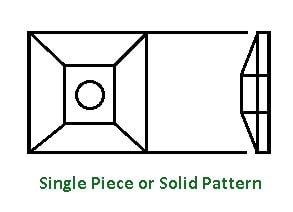
Solid pattern is generally used for large castings of simple shape. The simplest type of pattern is the flat-back as shown in fig. It may have few or no irregularities and it may not have a core-point.
When completed, the mould cavity will be entirely in the drag or entirely in the cope. A few examples of castings that are made by making solid patters are soil tamper, stuffing-box, and glad of the steam engine.
#2 Split Pattern
For casting unusual shape split patterns are used to form a mould. These types of pattern is usually made in two parts. One part will produce the lower half of the mould and the other upper half. The two parts may or may not be of the same size and shape.
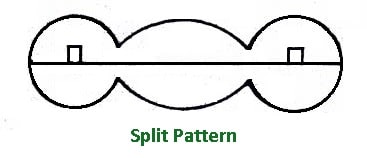
These are held in their proper relative positions by means of dowel-pins. Dowl-pins are faster in one-piece and fitting at the holes bored in the other piece. The surface which the parting line or parting surface.
The patterns are made in two or three pieces. Because many times the design of casting offers difficulty in mould making and withdrawal of patterns if a solid pattern is used.
#3 Multi Piece Pattern
Multi-piece patterns are widely used for intricate designs that are difficult to create. This type of pattern includes 3 or more patterns that help to create the mold.
If we consider a three-piece pattern, then it is a multi-piece pattern, which consists of top, bottom, and middle parts. The top part is copied, the bottom part is a drag, and the middle part is known a checkbox.
Read Also: What is Gear Cutting Process? It’s Advantages & Disadvantages
#4 Match Plate Pattern
These types of pattern is made in two pieces. One-piece mounted on one side of the plate and the other piece on the other side of the plate called the match plate pattern. The plate can only carry a pattern or a group of patterns on its two sides in the same way.
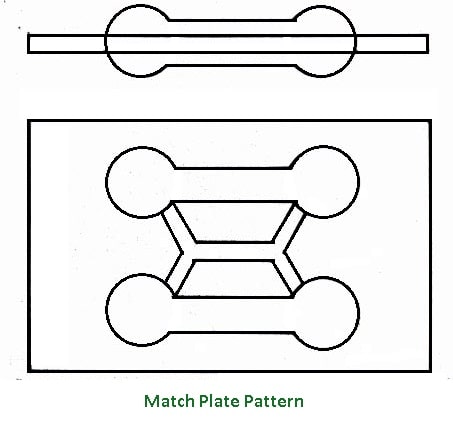
The plate is usually made of aluminum. The gate and runner are also connected to the plate with the pattern. These patterns are used where the rapid production of small and precise castings occurs on a large scale. These patterns are very favorable in machine moulding. Their manufacturing cost is quite high.
#5 Cope or Drag Pattern
When quite large castings are to be made, the entire pattern becomes too heavy to be handled by anyone operator. Such types of pattern is made in two parts which are individually moulded into separate moulding boxes.
One group of operators prepare the cope half of the mould sand and another group prepares the drag half. After completion of the moulds, the two boxes are assembled to form the complete cavity.
#6 Gated Pattern
Gated patterns are used in the mass production of small castings. For such castings, multi-cavity moulds are prepared i.e. a single sand mould carries a number of cavities as shown in the diagram. The patterns for these castings are interconnected by gate formers.
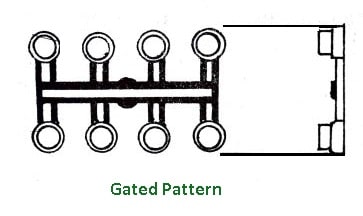
These gate formers provide suitable channels or gates in the sand for feeding the molten metal to these cavities. A single runner can be done to feed all cavities. This saves moulding time also there is uniform feeding of molten metal.
Read Also: Different Types of CNC Machine [Explained with their Working]
#7 Loose Piece Pattern
In these types of pattern, some single piece patterns are made to have loose pieces in order to enable their easy withdrawal from the mould. These pieces make an integral part of the pattern while moulding.
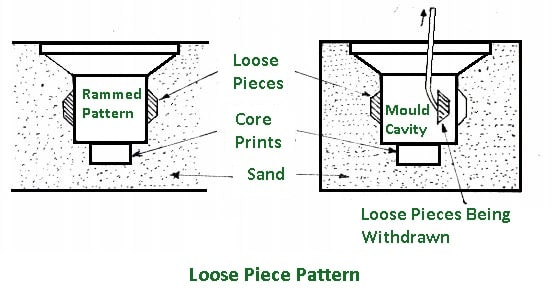
After the mould is finished, the pattern is withdrawn, leaving the pieces in the sand. These pieces are later withdrawn separately through the cavity formed by the pattern as shown in the diagram.
#8 Sweep Pattern
Sweep patterns are used for preparing moulds of large symmetrical castings, particularly of circular cross-section. Hence there is a large saving in time, labor, and material. The sweep pattern consists of a board that conforms to the shape of the desired casting.
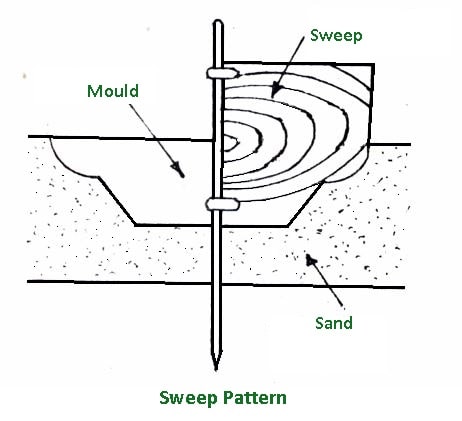
This board is arranged to rotate about a central axis as shown in the diagram. The sand is rammed in place and the sweep board is moved around its axis rotation to give the moulding sand the desired shape. The principle advantage of this pattern is that it expensive pattern construction.
#9 Skeleton Pattern
When the size of the casting is very large and only a few numbers are to be made, it is uneconomical to make a solid pattern of that size. In such cases, a pattern consisting of a wooden frame and strips is made, called a skeleton pattern.
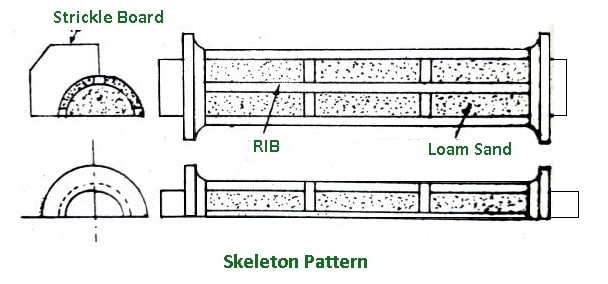
It is filled with loam sand and rammed. The excess sand is removed by means of a strickle. A half-skeleton pattern for a hollow pipe is shown in the diagram.
Since the pipe is symmetrical about the parting line, the same pattern will serve the purpose of moulding both the halves in two different flasks. These two flasks are joined later to form the complete cavity.
Read Also: Types of Grinding Machines [Complete Guide] with Diagram
#10 Segmented Pattern
These types of pattern is used to prepare moulds of large spherical castings. Hence the use of a solid pattern of the exact size is avoided. In principle, they work like a sweep pattern. But the difference is that a segmented pattern is a portion of the solid pattern itself and the mould is prepared in parts by it.
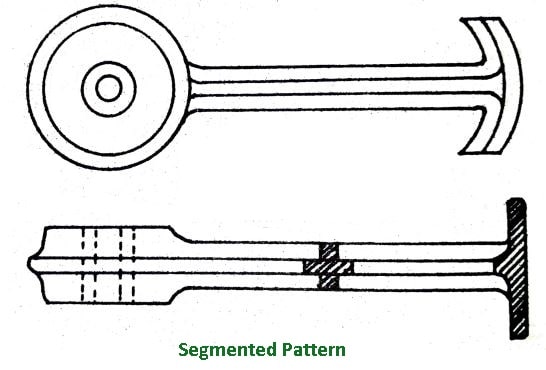
It is mounted on a central axis and after preparing the mould in one part, the section is moved to the next position. The operation is repeated until the complete mould is ready. A typical example is shown in the diagram.
#11 Shell Pattern
These types of pattern are largely used for drainage fittings and pipework. A typical example is shown in the diagram. The shell pattern is usually made of metal. It is mounted on a plate and parted along the centerline.
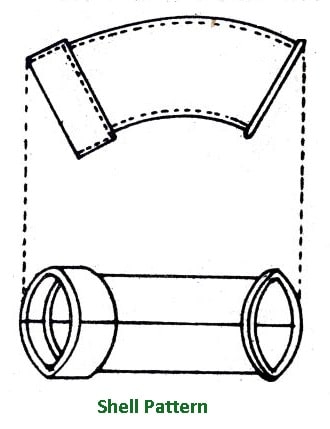
The shell pattern is a hollow structure like a shell. The outside shape is used as a pattern to make the mould while the inside is used as a core-box for making core.
#12 Follow Board Pattern
As the name implies, the follow board pattern consists of a wooden board that is used for a variety of applications. When casting structures are weak and may break after the applying of force, these patterns are employed.
Read Also: What’s the difference Between Up Milling and Down Milling?
Types of Pattern Allowances
The common allowances provided on patterns are:
- Shrinkage allowance
- Draft allowance
- Finish allowance
- Distortion allowance
- Rapping allowance
#1 Shrinkage Allowance
All the metals used for castings contract and shrink in size after solidification and cooling. To compensate for this, a pattern is made larger than the finished casting by means of a shrinkgae on contraction. allowance.
In laying measurements for the pattern, the pattern-maker allowas for this by using shrink or contraction rule. This rule is slightly longer than the ordinary rule of the same length. Different metals have different shrinkages. Therefore there is a shrink rule for each type of metal used in casting.
#2 Draft Allowance or Taper Allowance
When the pattern is drawn from a mould, there is a possibility of damaging the edges of the mould. This possibility is decreased if the vertical surfaces of a pattern are tapered slightly inward. This slight taper inside on the vertical surfaces of a pattern is known as the draft.
Draft is expressed in mm/meter on a side in degrees. Amount of draft needed depends upon:
- The shape of the casting.
- Depth of casting.
- Mouling method
- Mould material
#3 Finish or Machining Allowance
Rough surfaces of castings, that have to be machined, are made to dimensions somewhat over those indicated on the finished working drawings. The extra amount of metal to be machined is called finish or machine allowance.
This allowance varies from 1.5 to 16 mm but 3 mm allowance is common for small and medium-size castings. The edges of these surfaces are shown by a finish mark V or f. The amount of finish allowance depends upon:
- The kind o metal to be used
- The size and shape of casting
- Method of moulding
#4 Distortion Allowance
Distortion is seen only in such castings which have an irregular shape and contraction is not uniform throughout. Such casting will distort or wrap during cooling due to setting upm of thermal stresses in them. Such an effect is easily sen in some dome shaped or “U” shaped castings.
To eliminate this defect an opposite direction is provided in the pattern, so that the effect is neutralised and correct casting is obtained.
#5 Rapping or Shake Allowance
When a pattern is to be withdrawn from the mould, it is first rapped or shaken. As a result of this, the size of the mould cavity increases a little and a negative allowance is to be provided in the pattern to compensate for the same. This allowance may be considered negligible for small and medium-sized castings.
Read Also: Types of Sawing Machines and Their Uses [PDF]
Materials Used For Making Patterns
The common materials used for pattern making are:
- Wood
- Cast iron
- Brass
- Aluminium
- White metal
- Plastic
- Plaster
- Wax
#1 Wood
| Merits | Demerits |
|---|---|
| It is easy to work and readily available. Wood can be harvested and made into many forms by gluing, bending, and curving. | It is readily affected by moisture. |
| It is easily sanded to a smooth surface and may be preserved with shellac. | result of sand abrasion. If it is not stored properly, it may warp badly. |
| Wood wears out instantly as a Its strength is low and it may break on rough usage. |
#2 Cast Iron
| Merits | Demerits |
|---|---|
| It is strong and gives a good smooth mould surface with sharp edges. | Cast iron patterns are heavy and break easily. |
| cast iron is resistant to the abrasive action of the sand. | The iron pattern causes too much rust and requires a dry storage area. |
#3 Brass
| Merits | Demerits |
|---|---|
| When metal patterns are small, brass is used. It is strong, does not rust, and takes a better finish than cast iron. It is able to withstand the wear of the moulding sand. | Brass patterns are heavier than cast iron. |
#4 Aluminum
| Merits | Demerits |
|---|---|
| It is soft and easy to work. | Since aluminum is soft, its patterns may be damaged by rough usage. |
| It is light in weight and resistant to corrosion. |
#5 White Metal
| Merit | Demerit |
|---|---|
| The white metal has a low melting point. Can be easily into intricate shapes. | It is soft and easily worn away by the moulding sand. |
| It has no appreciable shrinkage. |
#6 Plastic
| Merit | Demerit |
|---|---|
| It is light in weight. It has high strength. High resistance to wear and corrosion. It gives a fine surface finish. it has low solid shrinkage. | Plastic patterns are fragile and hence light section requires metallic reinforcing. They do not work well when subjected to serve shocks. |
#7 Plaster
Merits
- Plaster can be easily cast into intricate shapes and can be easily worked also.
- Its extension can be easily regulated and it has a very high compressive strength.
#8 Wax
Merits
- Wax patterns are excellent for investment casting.
- Low ash content.
- High tensile strength and hardness.
Read Also: What is Extrusion Process? Types, Applications, Advantages
Factors Governing The Selection of Pattern Material
- Design of casting.
- The number of castings required.
- Method of moulding employed (hand moulding or machine moulding).
- Moulding material to be used.
- Chances of repeat orders.
Wrapping It Up
As you know now the pattern is a model of anything, made to form an impression called “mould”. Patterns are used to produce a mould cavity of exact size and shape. And by using a pattern, also minimizes the cost of castings.
That’s it thanks for reading. So now, we hope that we have cleared all your doubts. If you still have any doubts about “Types of Pattern” you can contact us or ask in the comments. If you like our article, then please share it with your friends.
Want free PDFs direct to your inbox? Then subscribe to our newsletter.
Download PDF of this article:
You may be interested in reading more articles like this: